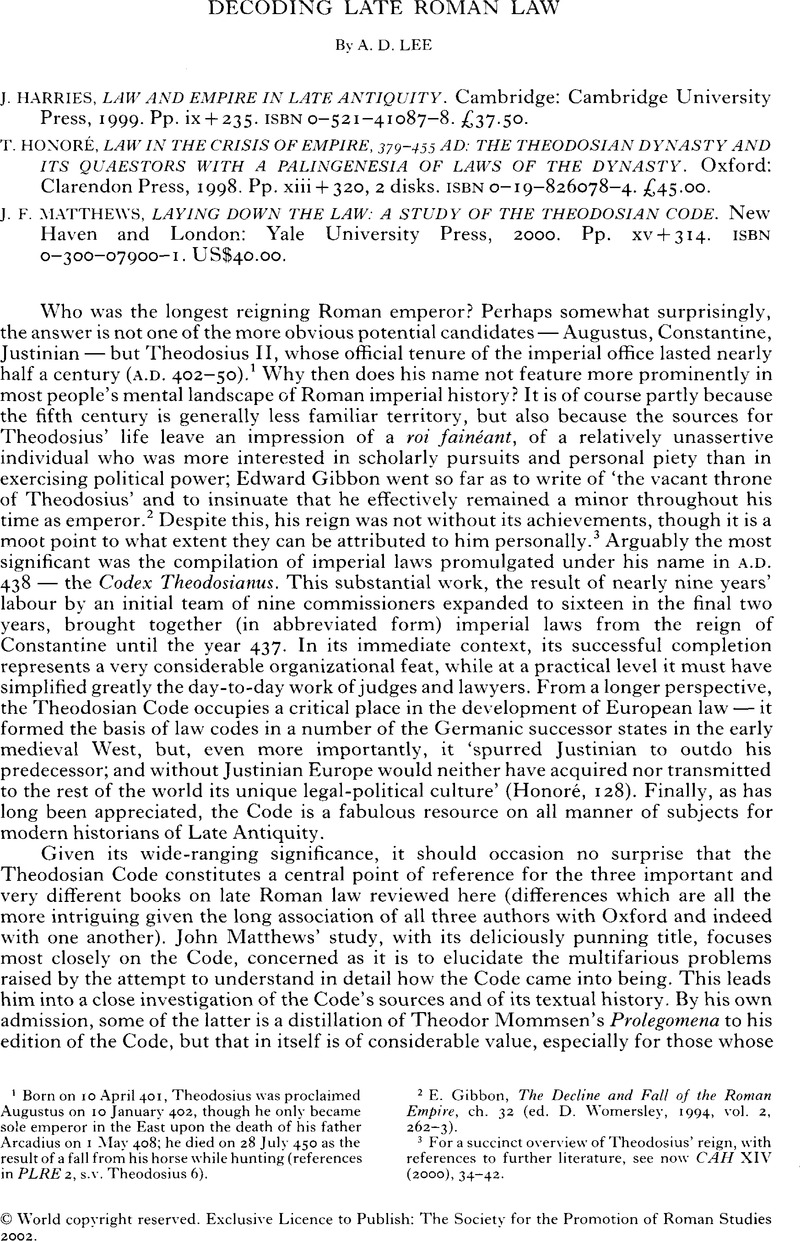Article contents
Decoding Late Roman Law
Published online by Cambridge University Press: 14 March 2012
Abstract

- Type
- Review Articles
- Information
- Copyright
- Copyright © A. D. Lee 2002. Exclusive Licence to Publish: The Society for the Promotion of Roman Studies
References
1 Born on 10 April 401, Theodosius was proclaimed Augustus on 10 January 402, though he only became sole emperor in the East upon the death of his father Arcadius on 1 May 408; he died on 28 July 450 as the result of a fall from his horse while hunting (references in PLRE 2, s.v. Theodosius 6).
2 Gibbon, E., The Decline and Fall of the Roman Empire, ch. 32 (ed. Womersley, D., 1994, vol. 2, 262–3).Google Scholar
3 For a succinct overview of Theodosius' reign, with references to further literature, see now CAH XIV (2000), 34–42.
4 Some of Matthews' page references to Mommen's Prolegomena require emendation: at p. 19 n. 27 and p. 30 n. 68, xi should be ix, while the nonsense page reference at p. 103 n. 44 (xcvvvi) should of course be xcviii — good illustrations of the sort of errors of transmission which beset the text of the Theodosian Code itself.
5 Ch. 9, on the legal interests of the author of the Historia Augusta (a revised version of a previous paper), seems peripheral to the volume's central themes.
6 cf. her more detailed argument on this point in ‘Pius princeps: Theodosius II and fifth-century Constantinople’, in P. Magdalino (ed.), New Constantines: The Rhythm of Imperial Renewal in Byzantium, 4th–13th Centuries (1994), 35–44, at 41–3.
7 Brennan, P., ‘The Notitia Dignitatum’, in Nicolet, C. (ed.), Les Litteratures techniques dans l'antiquité romaine, Entretiens Hardt vol. 42 (1996), 153–69, at 168Google Scholar.
8 ‘Constantine and the problem of anti-pagan legislation in the fourth century’, CPh 89 (1994), 120–39, at 132–9Google Scholar.
9 ‘Eternity in perishable materials: law-making and literate communication in the Roman Empire’, in Hillard, T. W. et al. (eds), Ancient History in a Modern University (1998), vol. 2, 253–65Google Scholar.
10 Now once again readily accessible, in a new translation with commentary by Trombley, F. R. and Watt, J. W., The Chronicle of Pseudo-Joshua the Stylite (2000) in the prolific and invaluable Liverpool University PressCrossRefGoogle ScholarTranslated Texts for Historians series.
11 Particularly Novels 8 and 80, with discussion by E. Patlagean, Pauvreté économique et pauvreté sociale à Byzance 4e–7e siècles (1977), 179–81; cf. also Roueché, C., ‘The functions of the governor in late antiquity: some observations’, Antiquité tardive 6 (1998), 31–6CrossRefGoogle Scholar.
12 For other important recent work in this area, see J. Beaucamp, Le Statut de la femme à Byzance (4e–7e siècles) (1990–92); D. Hunt, ‘Christianising the Roman empire: the evidence of the Code’, in Harries and Wood, The Theodosian Code, 143–58; J. Evans Grubbs, Law and Family in Late Antiquity: The Emperor Constantine's Marriage Legislation (1995); A. Arjava, Women and Law in Late Antiquity (1996).
13 Decline and Fall, ch. 44 (vol. 2, 789).
14 Harries does not discuss this issue in her book, but she has addressed it recently elsewhere, in ‘How to make a law-code’, in M. Austin et al. (eds), Modus Operandi: Essays in Honour of Geoffrey Rickman (1998), 63–78, making a similar case (I do not, however, understand the basis of her claim there (p. 66) that W. Turpin argues the Code is a Christian construct in ZSS 104 (1987), 620–30).
15 Notably R. MacMullen, ‘What difference did Christianity make?’ and ‘Judicial savagery in the Roman empire’, both reprinted in his Changes in the Roman Empire (1990), chs 13 and 20.
16 Lamoreaux, J., ‘Episcopal courts in late antiquity’, JECS 3 (1995), 143–67Google Scholar, absent from her bibliography, anticipates some of Harries' points and provides a useful supplement to her discussion. See also now the recently published volume edited by Ralph Mathisen, Law, Society, and Authority in Late Antiquity (2001), which includes three papers (by Noel Lenski, Leslie Dossey, and Harries herself) relating to episcopal involvement in the legal process, as well as much else of broader relevance to the subject matter of this review.
17 In the same spirit, I note the following slips over matters of detail. Harries: on p. 24 it is implied that the commission for the first edition of the Justinianic Code was set up on 13 February 529, whereas it was actually 528; had it been the former, it would have completed its work in a mere seven weeks, which would have demonstrated not just ‘great’, but extraordinary, speed! a number of items cited in the notes are missing from the bibliography of secondary works: Mommsen (1905) (p. 14 n. 42); Voss (1982) (p. 42 nn. 16–17); Watson (1995b) (and by implication Watson (1995a)) (p. 142 n. 53); Dewing (1934) (p. 182 n. 55). Honoré: Const. Haec was of course issued in 528, not 538 (p. 147 n. 270); at p. 249 1. 4, read ‘Aquileia’ for ‘Thessalonica’. Matthews: in Const. Tanta 23 the completion of the Digest is not connected with victory over Persia (p. 30 n. 69), but with the conclusion of the so-called ‘Eternal Peace’ (532), as its wording makes clear (‘bella Parthica abolita sunt et quieti perpetua tradita’); for the years after 437, the Justinianic Code drew on more than just ‘the Novellae of Theodosius II and his successors down to Anthemius, together with some laws of the first years of the reign of Justinian himself’ (90): as Appendix I to the Corpus Iuris Civilis vol. 2 (pp. 507–8)Google Scholar shows, it includes a significant number of laws of other emperors from the late fifth and early sixth centuries (e.g., Anastasius); ch. 7 n. 56 does not refer to an oration of Libanius, as claimed at p. 281 n. 1.
- 13
- Cited by




